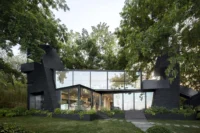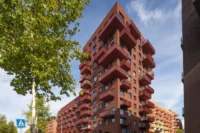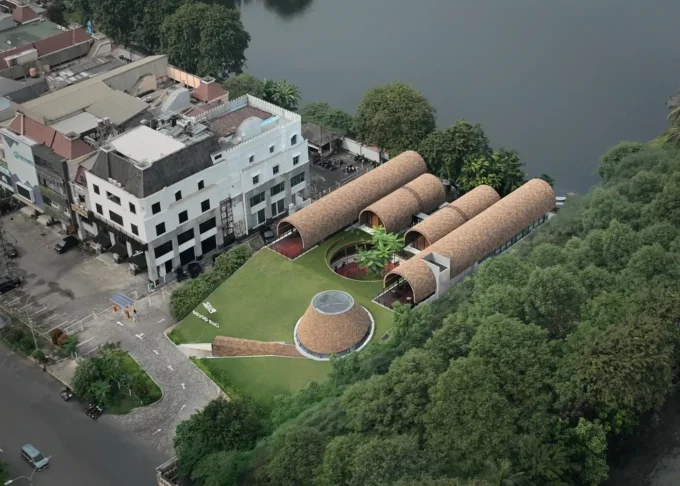In the tranquil embrace of Yingshan Lake, on the southwest edge of Yushan Park in Changshu, a quiet architectural transformation has taken place. The LIM Café Renovation by Parallect Design is more than a physical intervention—it is an exercise in cultural memory, spatial reuse, and poetic placemaking. By reimagining abandoned shipping containers, the project renews a once-forgotten corner of a nationally celebrated 5A-level tourist destination into a serene urban retreat that harmonizes built form with nature’s cadence.

A Container for Reflection and Reconnection
Yushan Park, often described as Changshu’s urban soul, is a space deeply embedded in the collective memory of the city. Here, the LIM brand, under the leadership of Changshu Cultural Tourism, seeks to weave cultural experience into the park’s natural fabric. The design begins with three retired shipping containers—structural remnants of past utility—and reinterprets them into a “third place” where city life pauses, and reflection begins.
The containers are stacked and oriented to form a modest café structure at the lake’s edge. Two serve as the ground-level seating and services zone, acting as a sound and visual buffer from the nearby pathways. The third, placed above, becomes a terrace café—a floating viewpoint from which visitors can survey Yingshan Lake and its ever-changing scenery. This setup capitalizes on the site’s quiet strength: its position just beyond the park’s primary axis, yet offering the most vivid panorama of the musical fountain and the distant silhouette of the historic Yushan city wall.

Designing Within Limits: Vertical Strategies and Historic Dialogue
The site’s location within a protected historic district imposed strict building constraints. The design could not extend beyond the original foundation, and all interventions required reversible methods. Rather than seeing this as a hindrance, Parallect Design embraced the vertical dimension as an opportunity. The result: three unique observation towers, each rising from one of the container corners, carving out new spatial narratives that elevate users—both physically and emotionally.
These towers function as spatial punctuation marks, offering diverse experiences of the landscape and encouraging visitors to slow down, climb, and observe.
-
North Tower – Whispering Among the Trees
Positioned at the forest’s edge, this two-story tower is designed for privacy and intimacy. It preserves two camellia trees growing through its steel structure, integrating nature into the built environment. In spring, blossoms peek into the interior, creating a tactile, fragrant connection with the seasons. Slatted windows are strategically positioned to maintain seclusion while framing the leafy exterior. -
South Tower – Lake Light Overture
Facing the park’s musical fountain, this is the most panoramic of the towers. The second level houses a 270-degree viewing lounge, while the third level is an open-air deck offering uninterrupted views of the fountain’s rhythmic choreography. Light, sound, and water converge here in a dynamic sensory display. -
East Tower – The Spacetime Corridor
As the main circulation node, this spiraling tower features a sculptural steel staircase that wraps around a preserved hackberry tree, blurring the line between architecture and ecology. A 30-degree tilt on the upper viewing deck aligns the visitor’s gaze with the historic Yushan city wall, creating a subtle visual dialogue that connects past and present, structure and story.

Architecture in Symbiosis with Nature
What distinguishes this project is its deep respect for existing site conditions. Rather than imposing a new vision onto the landscape, the design carefully extracts potential from the overlooked—rusted steel, local flora, and underused terrain. Each design move reflects an understanding of the park as a living memory, where nostalgia and modernity coexist.
The three black containers, modest in form yet rich in metaphor, become vessels of rebirth—quiet structures that reflect the lake’s stillness, the trees’ movement, and the sky’s color shifts. Their minimalist aesthetic contrasts yet harmonizes with the lush context, offering refuge for the senses.
A Living Room for the City
More than a café, the LIM space now serves as a public living room, where people can sit, breathe, reflect, and reconnect. Whether arriving for coffee, to read quietly, or to ascend the towers for a new perspective, visitors participate in an architecture that fosters contemplation and encounter.
The LIM Café Renovation is a delicate yet powerful statement about the value of small interventions, the reuse of existing resources, and the potential for architecture to slow time—to make space for stillness amid the rhythm of the city.
Photography: Shang Wang
- Adaptive reuse café
- Architecture and cultural memory
- Architecture and Nature
- Café renovation project
- Café with lake view
- Café with panoramic views
- Container reuse project
- Ecological design China
- Historic district architecture
- LIM Café Changshu
- Minimalist architecture China
- Observation tower design
- Parallect Design
- Park café architecture
- Shipping container architecture
- Small-scale urban intervention
- Sustainable café design
- Third place design
- Urban placemaking
- Yushan Park architecture


















































Leave a comment